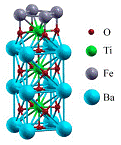Department of Physics and Astronomy: Publications and Other Research

Evgeny Tsymbal Publications
ORCID IDs
Tsymbal http://orcid.org/0000-0002-6728-5543
Document Type
Article
Date of this Version
2-19-2013
Citation
Physical Review B (2013) 87: 081406
doi: 10.1103/PhysRevB.87.081406
Abstract
Using a first-principles method we show that graphene based materials, functionalized with hydroxyl groups, constitute a class of multifunctional, lightweight, and nontoxic organic materials with functional properties such as ferroelectricity, multiferroicity, and can be used as proton battery cathode materials. For example, the polarizations of semihydroxylized graphane and graphone, as well as fully hydroxylized graphane, are much higher than any organic ferroelectric materials known to date. Further, hydroxylized graphene nanoribbons with proton vacancies at the end can have much larger dipole moments. They may also be applied as high-capacity cathode materials with a specific capacity that is six times larger than lead-acid batteries and five times that of lithium-ion batteries.


Comments
Copyright 2013, American Physical Society. Used by permission